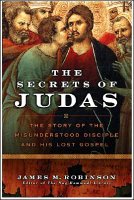 On July 1, 2004, the world was told that a new Coptic apocryphon had been discovered and was a copy of “the most condemned writing of antiquity: The Gospel of Judas.” First described by Irenaeus of Lyon around 180 AD, this document has been lost until it resurfaced in 1983. The text, in Egypt's ancient Coptic language, dates from the third or fourth century and is a copy of an earlier document, most likely written in 130 – 170 AD.
On July 1, 2004, the world was told that a new Coptic apocryphon had been discovered and was a copy of “the most condemned writing of antiquity: The Gospel of Judas.” First described by Irenaeus of Lyon around 180 AD, this document has been lost until it resurfaced in 1983. The text, in Egypt's ancient Coptic language, dates from the third or fourth century and is a copy of an earlier document, most likely written in 130 – 170 AD. In The Secrets of Judas: the story of the misunderstood disciple and his lost gospel, James M. Robinson undertakes a review of the apostle Judas, as portrayed in the Christian gospels, and tells the story of the discovery and sale of this priceless piece of history.
Gospel means “Good News” and the gospels, as we now know them, were written for evangelizing rather than simply to inform. As such, they were not meant to be a historical record. Both Matthew and Luke contain sayings of Jesus that are not included in Mark, and therefore must come from another, earlier, source. Scholars believe that the document, now referred to as “Sayings Gospel Q,” was a compilation of sayings of Jesus still to be proclaimed. This document, composed only of quotes, was intended for use only by the disciples in their ministry and does not refer to the disciples by name nor does it discuss Jesus’ public ministry. It is believed that this document formed the basis of Mark’s Gospel.
The first half of The Secrets of Judas includes a line-by-line comparison between the gospels of the Gentile Christian Church (Mark and Luke) and the Jewish Christian Church (Matthew). The Gospel of John, which does the most to discredit Judas, can be viewed as a polemic against him. In this section, Robinson looks at differences between the four Gospel texts and considers who may have implemented the various interpretations and why, focusing on the political differences between the two factions in the early Christian Church.
This first section helps provide a setting for the question many have been asking: “Will this new document, The Gospel of Judas, reveal secrets about Jesus and paint a new picture of Judas?” Robinson believes the text is valuable to scholars of the second century, but dismisses the notion that it will reveal unknown biblical secrets. In fact, scholars have already begun to look at Judas from a new perspective, casting a new light on the actions Jesus commanded he take. In 1996, William Klassen published Judas: Betrayer or Friend of Jesus?, one of the first serious studies on this subject.
 In the second part, Robinson describes secretive maneuvers and negotiations occurring in the United States, Switzerland, Greece and elsewhere over a two-decade period. In 1983, the Codex containing the "Judas" manuscript was offered for sale for a princely sum of $3 million. Robinson was approached to participate in the authentication of the document, but was unable to arrange funding for travel to Geneva. In his place, he requested Stephen Emmel travel from Rome to verify the value of the document, providing one of the few reports available on the manuscript.
In the second part, Robinson describes secretive maneuvers and negotiations occurring in the United States, Switzerland, Greece and elsewhere over a two-decade period. In 1983, the Codex containing the "Judas" manuscript was offered for sale for a princely sum of $3 million. Robinson was approached to participate in the authentication of the document, but was unable to arrange funding for travel to Geneva. In his place, he requested Stephen Emmel travel from Rome to verify the value of the document, providing one of the few reports available on the manuscript.Robinson traces the twisted trail taken by the manuscript and its sellers, leading to the Maecenas Foundation obtaining the manuscript and negotiating a contract with the National Geographic Society for its study. The publication of The Gospel of Judas and The Lost Gospel: The Quest for the Gospel of Judas Iscariot, and the release of the National Geographic special about the discovery and translation of the Coptic document in April 2006, marked the first opportunity scholars have had to view and work on The Gospel of Judas.
While The Secrets of Judas: the story of the misunderstood disciple and his lost gospel does not include a copy of the Coptic text or its translation, what Robinson includes in his book is equally important. A true understanding of this priceless document can only be gained by understanding its place within the canon, and the political dimensions that contributed to its long absence.
James M. Robinson is the former director of the Institute for Antiquity and Christianity and Professor Emeritus at The Claremont Graduate School. An international leader of those studying Coptic manuscripts, he is best known for his work on the Nag Hammadi Codices.
See a condensed review posted at Armchair Interviews.
Publication Date: April 1, 2006
Publisher: Harper SanFrancisco
Format: Hardcover
ISBN10: 0061170631
ISBN13: 9780061170638
Related Books of interest:
* The Gospel of Judas by National Geographic Society, Bart D. Ehrman, Rodolphe Kasser, Marvin Meyer and Gregor Wurst
* The Lost Gospel: The Quest for the Gospel of Judas Iscariot by Herbert Krosney
* Judas: Betrayer or Friend of Jesus? by William Klassen
* The Lost Gospel of Judas Iscariot: A New Look at Betrayer and Betrayed by Bart D. Ehrman
tags: books book reviews Secrets of Judas James M. Robinson Gospel of Judas


3 comments:
Wow. This sounds rather interesting. Every once in a while a book that probably wouldn't catch my eye comes to my attention. I might have to look for this one at the library.
It's written in a very accessible way and is a quick, yet fascinatingm, read.
Dear Janelle,
I would like to invite you to write a short review of a new Christian ebook called Land of Canaan: Ancient Hope for Future Peace. See it free online at www.landofcanaan.info and let me know what you think.
Thanks,
Paul
Post a Comment